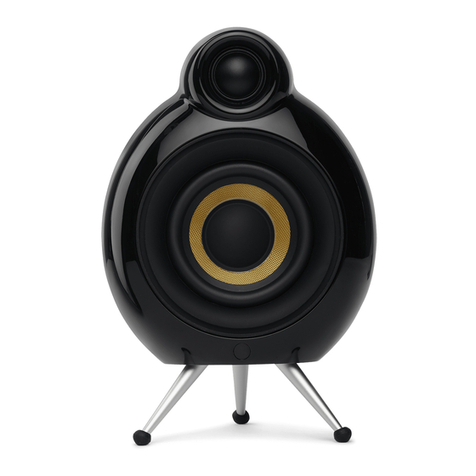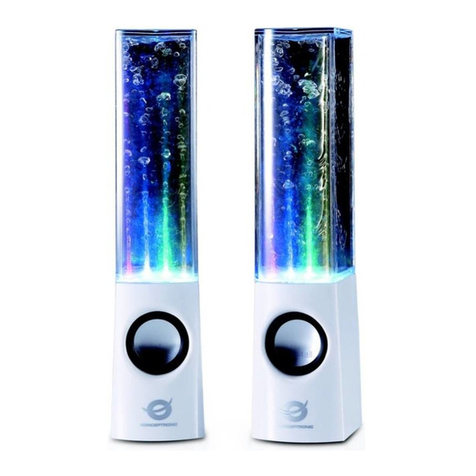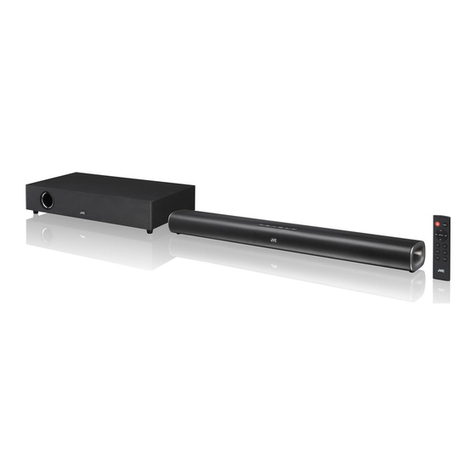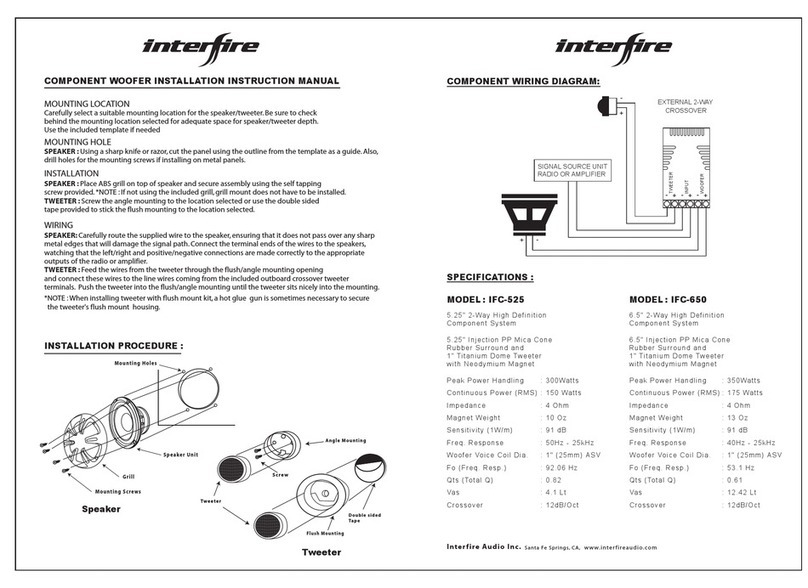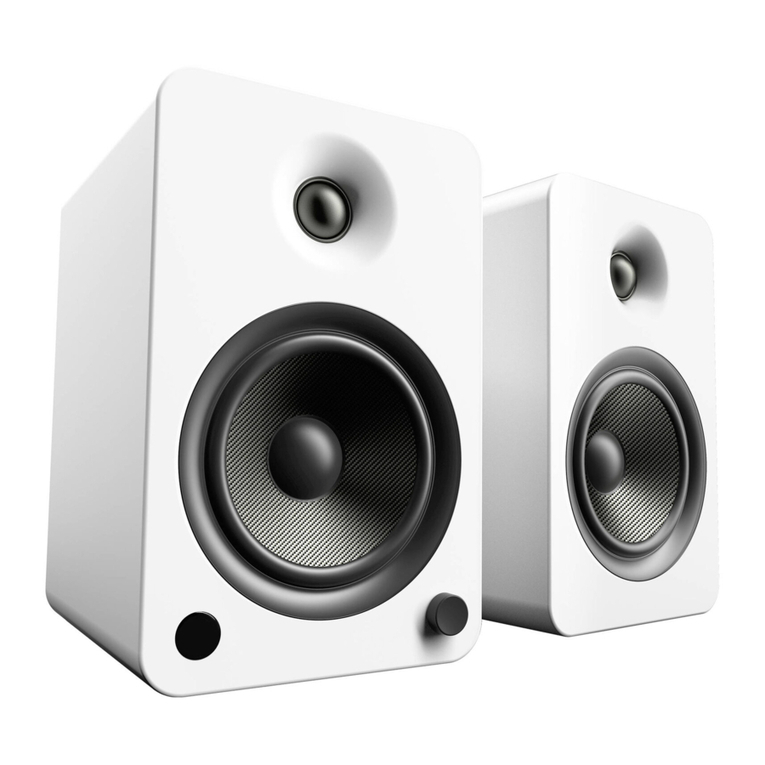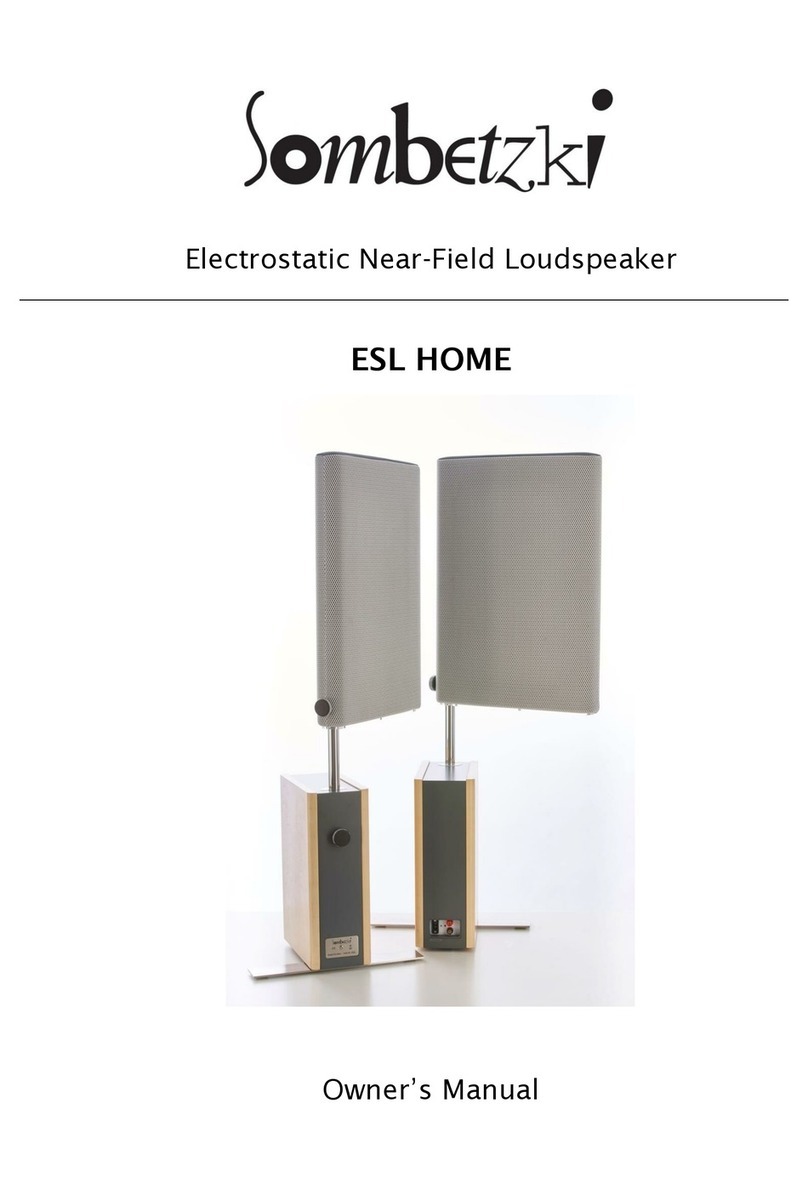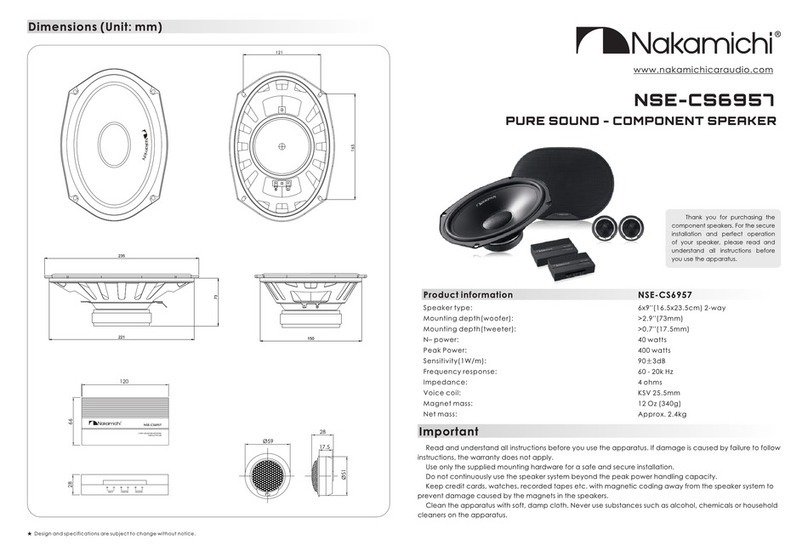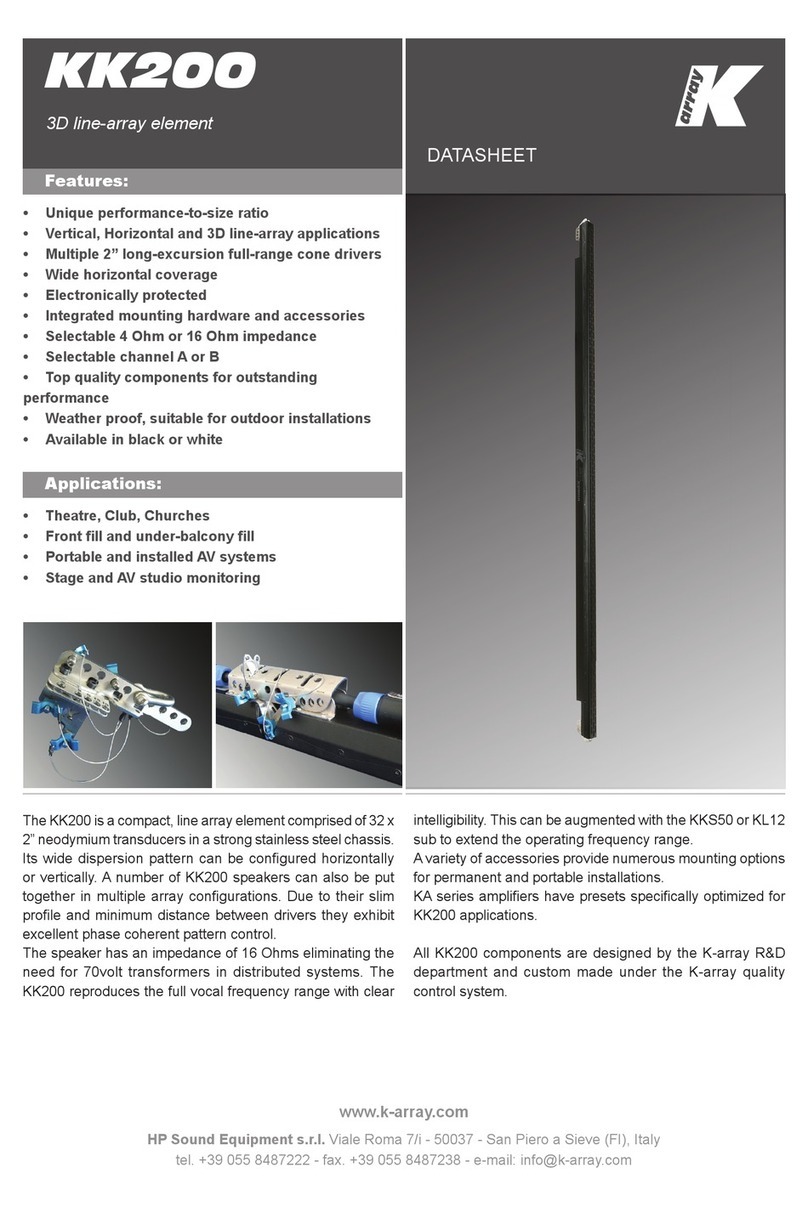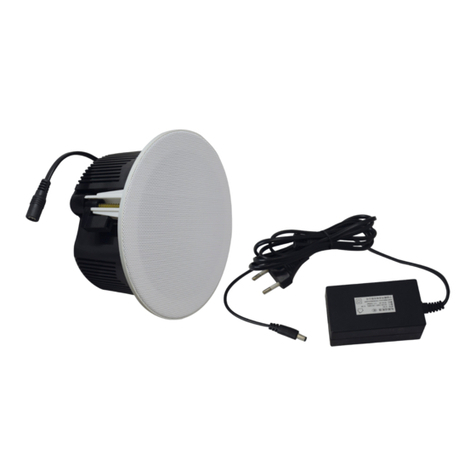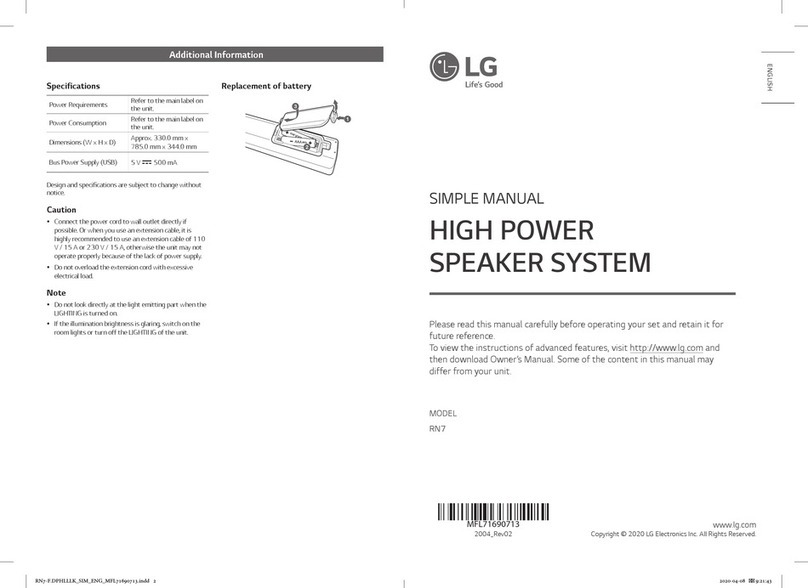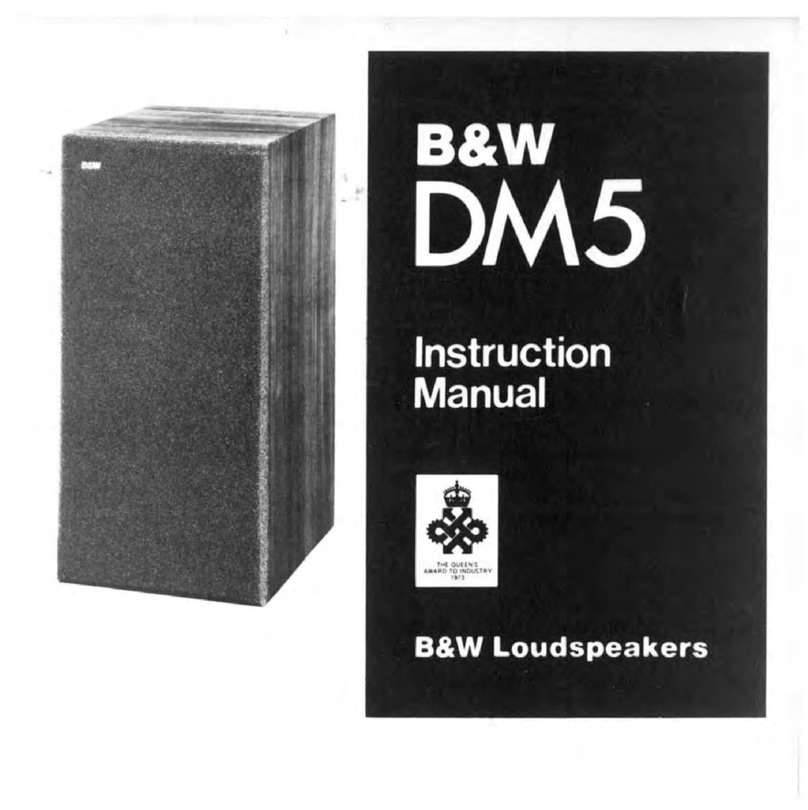B-I-C America Acoustech AuraPro Series Installation instructions

AuraPro series In-Ceiling speaker
Installation and Owner’s Manual
Acoustech

TABLE OF CONTENTS
What you need to do the job
Speaker parts inventory 2................................................
Tools for installation 2................................................
Speaker wire 3................................................
Amplifier considerations 3................................................
Where to put your speaker(s)
Various uses 3................................................
Background music 3................................................
Surround sound 3................................................
Other acoustic considerations 3................................................
Wall & ceiling surfaces 4................................................
Speaker wire paths 4................................................
Painting the speaker(s) and grille(s) 4................................................
Cutting holes for the speaker(s) 4................................................
Running connecting wire(s) 5................................................
Hooking up your speaker(s)
At the speaker end 6................................................
At the amplifier end 6................................................
Final assembly 6................................................
A short “test drive” 6................................................
A quick troubleshooting guide 7................................................
Front panel controls
Home Theater (5.1 Channel) Layout 7.............
Home Theater (7.1 Channel) Layout 7.............
Using the AU620 or AU820 as a “Single Point Stereo” Speaker 8......
Further reading
Taking care of your new in-ceiling speaker 9.............
More on amplifiers and impedances 9.............
Installing Acoustech speakers during new construction 9.............
Specifications 10...........
Acoustech AuraPro series description and specifications 11........
Limited Warranty 11...........
CONGRATULATIONS
Thank you for selecting this Acoustech Ceiling Speaker. Like all
Acoustech speakers, the AuraPro series combines advanced acoustic
technology with durability and will provide years of musical enjoyment.
This manual is designed to make your ceiling speaker as easy to install
as it is to listen to. If you’ve had any home “do-it-yourself” experience,
you should find installation of your new speaker a simple job.
However, we suggest you read through this manual before starting out.
If you then decide that installing your Acoustech Ceiling Speaker is
beyond your skills, we recommend the use of a professional installer.
A
WHAT YOU NEED
TO DO THE JOB
Before you get involved in the actual
installation process, it’s a good idea to
check for possible shipping damage
and identify parts and hardware. !
You should have the parts shown in
Drawing 1: !
•One (1) Acoustech loudspeaker with
one metal grille !
•White cardboard template: one
cutout template !
If anything is missing after a thorough
search of the box and packing
materials, contact the dealer where
you bought your speaker. !
Although Acoustech Speakers are
extremely well packed to withstand the
rigors of shipping, you should still
inspect them closely, especially if there
is any damage to the outside carton. If
you find anything wrong, contact your
dealer or the shipper who delivered the
speaker. !
C
A
D
E
F
G
B
H
I
J
DRAWING 1
SPEAKER SYSTEM PARTS
INVENTORY
It doesn’t take a whole workshop to
install your new speaker, just a few
simple tools: !
•A pencil !
•A drill with a 1-inch flat bit !
•A retractable utility knife or keyhole
saw !
•A length of stiff wire about 3 feet
long (a straightened wire coat hanger
works fine) !
•A Phillips-head screw driver !
•A pair of diagonal pliers or wire
strippers Some of the following may
also be needed, depending on the
application. !
•A stud finder !
•Drill bit just slightly larger than the
diameter of one speaker wire !
•Plumb bob or small weight on a
string!
•Insulated staples for securing
speaker wire!
•Masking tape or foam “double-stick”
tape!
•Paint and applicator for changing
grille finish
TOOLS FOR INSTALLATION
IN EXISTING WALLS
2

B
SPEAKER WIRE
The amount of wire you’re going to need
will vary with speaker placement (which we
cover next). But we’re covering the subject
of wire now because it’s something you
may have to go out and obtain along with
whatever tools you don’t already have.
What kind to use
Acoustech ceiling speakers may be
used for surround and rear sound
channels by placing them (1) behind
or (2) in the ceiling, just behind the
viewer.
We recommend using inexpensive, multi
stranded “zip-cord” for amplifier-to-speaker
connections. Also called lamp cord, it’s sold
in pre-packed rolls and in bulk displays at
hardware, lighting and home improvement
stores. Zip-cord’s outside covering
(insulation) can be transparent, black,
brown, white, etc. Color doesn’t matter.
Wire-thickness does. For in-wall and in-
ceiling, a good quality wire should be used
so the outside plastic covering won’t crack
and break down over time.
Selecting the proper gauge
Wire is measured in “gauges”. For no
particularly good reason, the bigger the
number, the smaller the wire. For example,
18-gauge is thinner than 14-gauge.
The gauge of wire you need is determined
by the distance between your amplifier/
receiver and the speakers. Use the
following chart as a guide:
If in doubt, be safe and get a smaller gauge
(i.e. thicker wire). Using too thin a gauge
over a long distance can compromise
sound quality. And besides, there isn’t a
vast cost difference between gauges.
How much to buy
Basically, more than you think you need. As
we noted earlier, a discussion of lengths is
sort of premature until you’ve decided on
exact placement, so you may want to skip
to Section B on "Where to put your
speakers.” But if you have a rough idea of
the distance from your amplifier to the
speakers, here are a few tips:
• Because of the complicated paths which
are often required to route wires, you’ll
definitely need more than the amount
derived from simple measurements.
• Even if one speaker is a lot closer to the
amp than the other speaker, you should
use the same length of wire for both
paths. This insures that both speakers will
play at equal volume.
• Professional installers often use the
following rule of thumb: “As the crow flies”
amp to speaker distance TIMES FIVE.
That allows enough for both speaker
paths plus a very healthy margin for
unplanned detours. Remember the
electrician’s favorite adage: “You can
always cut off extra wire, but you cannot
make wire longer once it is cut.”
DRAWING 2
Amplifier considerations
Virtually any receiver, power amplifier or
integrated amplifier can be used with your
Acoustech Ceiling Speaker. Although
Acoustech speakers are rated for high
power, it’s OK to use an even more
powerful amplifier if you take some simple
precautions, which we
cover on page 9 (“Taking care of your new
in-ceiling speakers”).
A more serious consideration is whether or
not you intend to power more than one set
of speakers with the same amplifier or
receiver. If you intend to hook speakers to
both “A” and “B” receiver outputs and then
play both sets of speakers at the same
time, you should read the section starting
on page 9 of this manual (“More on
amplifiers and impedances”), to avoid
potential problems.
WHERE TO PUT
YOUR SPEAKER(S)
Since these are primarily used in ceiling
applications, we highly recommend
installing in an open attic space. If you
need to go into the ceiling of a first floor
ro om ( in a t wo s to ry h ou se ), w e
recommend the use of a professional
installer.
DRAWING 3
Placement can make all the difference in
how your Acoustech speaker systems
sound – and how easy they are to install.
There are at least three
“WHERE’S” and a “HOW” to factor into
your layout:
• HOW you intend to use your speakers
• WHERE they’ll sound best (acoustic
considerations)
• WHERE it’s possible to install them
(ceiling surfaces)
• WHERE they can be installed that makes
it easy to get wire to them without
remodeling your entire house.
VARIOUS USES
Acoustech Ceiling Speakers can be used
for background music, as a primary
listening system, or as built-in surround and
rear speakers in an audio/video home
theater.
Background music
If you just want low-volume background
music to float through a room, placement
for best acoustics is not particularly critical.
You can pretty well ignore all our diagrams
and tips on imaging and other acoustical
matters. Just put your speaker where it’s
convenient and non-intrusive to room
decor. You can even place the speaker in
an adjoin- ing room, such as a living room
that flows into a formal dining room, or in a
kitchen and breakfast nook.
Surround sound
Aco ust ech Ce ilin g Spe aker s make
excellent surround sound speakers. They
can be mounted in any of the positions
shown in Drawings 2 and 3, especially from
the ceiling.
OTHER ACOUSTIC
CONSIDERATIONS
For best fidelity, there are several other
factors to keep in mind before you start
actual installation.
DRAWING 4
Vertical Placement
Treble frequencies are
quite directional. While
the dome tweeters in
Acoustech AuraPro
series speakers are
designed to disperse
high frequencies over a
wide area, they will give
you the best sound
when positioned so that
they cover the listening
area in a cone of
coverage as shown in Drawing 4. Of
course, if the speakers are being installed
in an area where listeners usually stand up
(such as a kitchen or hallway), they are
best suited for ceiling mount
(see Drawing 3).
Corners and reflections
When a speaker is placed close to the
corner of a room, bass frequencies are
emphasized.
Treble is emphasized when it reflects back
from reflective surfaces such as large
windows. Conversely, highs tend to be
muffled by soft surfaces such as drapes,
rugs, upholstered furniture, carpeted steps
and even textured fabric wall paper.
3

C
D
WALL & CEILING SURFACES
Now that we’ve covered where you should
put your speakers, let’s consider where you
CAN put them.
The installation depth requirements for the
AuraPro series speakers, please refer to
the specifications table on page 10.
(measured from the outside surface of the
wall). This means that they can be installed
in any space wide and deep enough for
them, including most ceilings.Ceiling
plasterboard (or lath and plaster in older
homes) acts as a superb speaker baffle.
Because the depth of AuraPro series
ceiling speakers is deeper than typical 2 !x
4 !wall studs, AuraPro series speakers
cannot be installed in most walls.
Avoid:
• Ceilings covered only with thin veneer
paneling – the surface isn’t rigid enough
and can cause annoying vibrations and
buzzing.
• T-bar “drop ceilings” with very thin
fiberboard panels which can buzz and
vibrate. If you suspect this will happen,
reinforce the drop-in panel with wood or
particle board.
• Any wall which can’t provide proper depth
(clearance) for the back of the AuraPro
series speakers to protrude. This includes
brick
or concrete walls where the wallboard or
paneling is attached to thin furring strips.
• Ceilings where you know that there are
pipes, heating ducts and ESPECIALLY
AC wiring in the general vicinity.
SPEAKER WIRE PATHS
The last consideration is the obstacle
course that lies between the speakers’
hoped-for mounting positions and your
stereo system.
Wire can be run through crawl spaces that
lie above your ceiling or below the floor,
through basements of second stories, or
simply along the perimeter of your listening
room. We cover each of these options in
detail in the “Running connecting wires”
section of this manual.
In general, you should pay particular
attention to the following areas:
• Avoid running speaker wires close to
house electrical wiring for any distance. If
you have to run them parallel, make sure
to space the speaker wires at least two
feet from the AC line. It is, however, OK
for speaker wires to cross paths with AC
line or go through the same hole together
with house wiring if they separate before
and after.
• Make sure that the entire path between
speakers and amplifier is clear and not
obstructed by a major floor or ceiling joist
or masonry wall which you won’t be able
to drill through.
• Remember that the other end of the wires
has to come out somewhere to connect
with the amplifier. Confirm ahead of time
that you can drill an outlet hole easily and
in an unobtrusive spot.
DRAWING 5
Both the speaker frames and the grilles can
be painted, if desired. We recommend
doing this before installation. Always paint
the grilles separately from the speaker
itself.
First, remove the white scrim cloth from
behind the grille. The grilles should only be
spray painted very lightly to avoid clogging
the fine mesh of the grille and restricting
the sound. Once the grille is dry, replace
the scrim cloth by gently placing it behind
the grille. No adhesive is necessary gravity
will keep it in place (see Drawing 5).
Only install the speakers and grilles once
the paint has dried thoroughly.
Wallboard is an easy surface in which to
make a relatively neat hole. Actually, the
hole doesn’t even have to be that neat,
since the speaker’s outer frame will cover
it. Just make sure you don’t make it any
bigger than the template. In the following
steps, you’re going to locate a section of
ceiling between the wood framing or in the
wall between two studs, mark the outer
boundaries of the hole, drill a small hole in
the center to confirm
your location and then cut the main hole.
1. First you must determine the location of
your ceiling supports so that the speaker
can be approximately centered between
them. There are several ways to go about
this:
·Tap on the surface and listen to the result-
ing “THUMP”. When it’s deeper, you’re
between studs. When it’s sharper and more
flat-sounding, you’re close to a stud.
·Use a stud-finder, a simple little device
which works by locating the studs behind a
wall.
·Identify wall studs by the position of
electrical outlets or switches. There will be
a stud either directly to the left or right of an
electrical fixture. This gives you a point of
measurement, since studs are either 18 or
16 inches apart in newer houses, 12 inches
apart on pre-WW2 homes.
CUTTING HOLES
FOR THE SPEAKER(S)
PAINTING THE
SPEAKER(S) AND
GRILLE(S)
DRAWING 6
4

E
F
2. When you’re reasonably sure of where
the ceiling joist (studs or framing) are (and
are TOTALLY sure that there isn’t an
electrical cable, water pipe or heating duct
in that vicinity of your proposed cutout)
position one of the cardboard mounting
templates and draw around the inside
outline with a pencil.
3. Drill a 1-inch hole in the center of the
pencil outline which you have just drawn.
4. Obtain a length of stiff wire such as an
un- wound, totally un-bent coat hanger.
Bend it so that the last 12 inches is at a
right angle to the rest.
5. Insert the angled part into the 1-inch hole
you just drilled and probe to left and right to
con- firm that a stud is not close on either
side.
6. If there is a close stud on one side, just
re-position the cardboard template a few
inches in the opposite direction and re-draw
your pencil outline, keeping the 1-inch hole
within the pencil outline’s inner boundaries.
• If there are no obstructions, cut the hole
along the pencil outline. If the surface is
wallboard, simply cut it increasingly
deeper with a utility knife until it gives way
and then pull it out by grasping the cut-
out through the 1-inch hole. ·If you’re
dealing with lath and plaster or thick
paneling, you need to use a different
technique. Drill 1-inch holes at opposite
sides of the pencil outline.Then use a
keyhole saw or a hacksaw blade with
VERY slow strokes to saw through and
remove the inner surface.
7. Temporarily place the Acoustech speaker
into the cut-out to insure that it fits properly.
It’s OK if the hole is slightly large, since it
will be covered by the speaker’s outside
frame. Actual installation will happen later,
after you’ve routed the speaker wires.
8. Repeat if installing more than one
speaker.
9. Now it’s time to drill the hole on the
OTHER end – at the point where the wires
from the speakers will exit to the amplifier/
receiver.
• Use the same 1-inch drill bit as before.
• If you want a totally finished job, install an
outlet box against a stud and cover it with
a TV cable or single outlet plate which
has one hole in the middle for the wires to
exit from.
DRAWING 7 DRAWING 8
Now you know where the wires have to run.
It’s time to actually route them.
If you have an attic or overhead crawl
space, your two steps are:
1) Route wire(s) up from the amplifier to the
crawl space;
2) Route wire(s) across the crawl space to
the speaker(s).
RUNNING CONNECTING
WIRE(S)
ROUTING WIRE UP TO SPEAKER
(ATTIC CRAWL SPACE) - DRAWING 7
1. You’re about to ascend into your attic.
Grab the following:
·Tape measure
·Cordless drill with a 1-INCH BIT (or
non-cordless model with long extension
cord)
·A VERY long roll of speaker wire
·Wire cutters – either diagonal pliers or
wire strippers which include a cutting
surface.
·Plumb bob or string with a small weight
(such as a metal nut) on the end
·Tape – any kind will do
2. Crawl up into the attic with all the afore-
mentioned stuff and proceed to a spot
that’s directly over a speaker cut-out
hole.
3. Time to use that roll of cable. Push a
cable through the speaker cut-out.
4. Making sure the end doesn’t get pulled
back up through the hole, reel out cable
while moving across the attic/crawl
space until you reach the location above
your amplifier.
5. Extend at least 10 (TEN) more feet of
cable for the roll and cut it.
6. You now have a cable running from the
speaker. Repeat steps above if installing
more than one speaker. Time to get them
down the wall to where the amplifier will
be.
7. Drill a 1-inch hole through the horizontal
2 x 4 directly above the amplifier wall
outlet.
8. Now you’re going to guide cables down
to where they’ll emerge from the wall.
Since this hole isn’t too big, just stuffing
them down and grabbing them won’t
work.Instead, it’s time for the plumb bob
or string-with-weight (or wire if there’s
insulation to contend with). Tape the two
cable ends (which come from the
speaker) to the plumb bob string just
above the weight and lower the whole
thing down through the 1-inch hole
above the amplifier. You’ll likely have to
“feed out” the attached cable to get the
weight to descend.
9. Continue “feeding out” both cables until
they and the weight hit bottom. Tie the
free end of the plumb bob string to
something so that it doesn’t fall down the
hole.
10.Exit the attic crawl space.
11.Go over to the 1-inch amplifier wire hole
and look for the extended string/plumb
bob and attached cables. If they’re not
visible, fish around for them with your
stiff wire/unbent coat hanger and pull
them through the hole.Then rescue the
plumb bob from the attic.
12.At the speaker hole, things are much
easier. You can just reach through and
grab the cables. Pull their whole free
length out the cut speaker hole. You’ve
done it!
The main thing to remember when hooking
up a speaker is that two conductors in the
speaker wire are not interchangeable. One
will be used as a POSITIVE (+) conductor
and the other as a NEGATIVE (–)
conductor. These correspond to the RED
(+) and BLACK (–) connectors on your
Acoustech Ceiling Speaker and also to the
speaker terminals on your amplifier or
receiver.
HOOKING UP YOUR
SPEAKER(S)
IDENTIFYING “+” and “–”
You need to be able to discriminate
between the two conductors in the zip cord.
If your wire has transparent insulation, this
is easy: One conductor will be copper-
colored and the other silver-colored.
Generally, professionals denote the copper
one as POSITIVE
(+) and the silver one as NEGATIVE (–). If
you’ve used wire which has an opaque
insulation, there are still differentiating
markings. Examine the wire closely and
look for:
·A series of ribs or grooves on one
conductor
·A painted stripe
·A single strand of yarn intertwined with the
multi-stranded wire in one conductor.
Denote any of these as the POSITIVE (+)
conductor for similar connections on both
ends.
5

G
1. Cut off excess wire, leaving about 2 feet
extending through the speaker cut-out
hole.
2. Pull the conductors apart so they’re
separated for the first two inches from
their ends.
3. Using wire strippers, diagonal pliers or a
knife, remove 1⁄2 inch of insulation from
each conductor.
4. Twist the tiny strands in each conductor
into tight spirals, as shown in Drawing 8.
5. IMPORTANT: Route the speaker wire
THROUGH the hole in the ceiling
(Drawing 9).
6. Attach the speaker wires to the red and
black speaker terminals. Press down on
the protruding levers while inserting the
wire into the hole (Drawing 9).
·Connect the POSITIVE (+) conductor to
the RED terminal and the NEGATIVE (–)
conductor to the BLACK speaker
terminal.
·Make sure that no stray strands of wire
have gotten detached and are touching
the other main wire.
AT THE SPEAKER END
1. Cut off excess wire, leaving enough to
comfortably reach from the hole in the
wall to your stereo system. If there’s a
possibility that you’re going to move the
amplifier to another part of the room,
consider leaving some excess wire
coiled up. If you’ve used sufficiently thick
wire, this extra length will not affect
speaker performance and
could make things easier if the room is
rearranged later.
2. Pull the conductors on speaker wire(s)
apart so they’re separated for the first
two inches.
3. Using wire strippers, diagonal pliers or a
knife, remove 1⁄2 inch of insulation from
each conductor.
4. Twist the tiny strands in each conductor
into tight spirals.
5. Attach the speaker wires to the red and
black speaker terminals on the amplifier
or receiver.
·Connect the POSITIVE (+) conductor to
the RED terminal and the NEGATIVE (–)
conductor to the BLACK speaker
terminal.
AT THE AMPLIFIER END
DRAWING 9
·Connect the POSITIVE (+) conductor to
the RED terminal and the NEGATIVE (–)
conductor to the BLACK speaker
terminal.
FINAL ASSEMBLY
1. If you haven’t done so already during
paint- ing, remove the perforated grilles
from your Acoustech Ceiling Speaker. To
remove the grille, just use the mounting
screw (dog leg) on the rear to push the
grille off.
2. See Drawing 10. Make sure all the
clamping brackets (dog legs) are turned
inward as shown in the picture before
going up on the ladder to install the unit
in the ceiling.
3. Find the wire you ran previously
(hopefully hanging down through the
hole you cut). Strip the ends if you
haven’t already done so and connect as
described in Section F.
4. Insert the speaker into the cutout hole
and be certain the wire is not hanging
down on the woofer cone.
5. Using a Phillips screwdriver (or powered
screwdriver, recommended), start
tightening the six screws. As you start
the tightening each of the mounting
brackets (dog legs) will swing around
and follow the screw down to the back of
the ceiling and clamp the speak- er into
place. Avoid excessive force when
tightening the screws to prevent
deforming the drywall or breaking the
plastic clamp of the speaker. Be sure to
go around all six screws and check for
even tightness in the clamping pressure.
6. Now is the time to aim the tweeter
toward your primary listening area.
Gently tilt and rotate the tweeter rim so
the centers are aiming toward the area
you want (See Drawing 11).
7. To attach the speaker grille, position the
grille over the speaker frame. Powerful
magnets embedded in the frame will
draw the grille towards the frame. Be
sure the grille is centered properly over
the frame and that it snugs down to the
correct centered position.
DRAWING 10
DRAWING 11
A SHORT TEST DRIVE
At this point, it’s a good idea to test every-
thing out.
Home Theater System
If you have connected your new Acoustech
Ceiling Speakers to the rear “surround”
output of your receiver, you will need to put
your receiver in the “Pro-Logic” or “Digital”
mode and use a source such as a DVD
player or suitably recorded movie to test
your receiver surround operation.
Stereo Music System
1. Turn on your stereo system. Make sure
that the VOLUME control is turned down
and that the BALANCE control is set to
center.
2. Activate a musical source such as FM or
a CD player.
3. Gently turn up the volume. You should
hear music coming out of your new
Acoustech Ceiling Speakers! (If you
don’t, refer to the troubleshooting guide
on the next page. We suggest you read
the section on page 9 titled “Taking care
of your new in-ceiling speaker” (for
further operating tips).
6
H

I
This control adjusts the relative level of high
frequency output to compensate for varying
room acoustics or placement behind a screen.
Front Panel Controls
High Frequency Level Control
DRAWING 12 DRAWING 13
"+3dB" is for absorptive, acoustically "dead"
rooms (or when the speaker is behind a movie
screen). Use this position to increase the High
Frequency level and restore the proper sparkle
and liveliness to the sound.
"HF" is for rooms of average absorptive
characteristics.
"-3dB" should be used in rooms that are highly
reflective, with hard floors and exposed
windows.
The setting of the HF control is mostly a matter
of personal taste, so try it in all three positions
and see which one is preferred (see drawing 12
& 13).
This control adjusts the relative level of the
midrange frequency output to compensate for
placement behind a screen.
"MID" delivers the flattest output for placement
behind a perforated screen.
"+3dB" increases the midrange frequency
output slightly.
"-3dB" reduces the midrange frequency output
slightly.
This control can also be used to adjust for
different room acoustics (see drawing 13).
Midrange Frequency Level Control
(AU820 only)
In Dipole mode the AU620/AU820 produce
ambience with minimal localization (best for
most movies and video soundtracks).
In Bipole mode they produce more localizable
sound (preferred for some music recordings).
Dipole/Bipole Operation of AU620 and
AU820 Speaker
DRAWING 14
Switching between Dipole and Bipole mode is
easily accomplished using a slide switch
located on the front of the speaker. Please note
that the vast majority of the time in movies and
TV broadcasts the surround speakers are called upon to reproduce the
environmental sounds that are used as cues to help get you immersed in the
scene on the screen. Once the surround speakers are properly positioned in the
listening area, we recommend that you begin with the dipole mode, as this usually
delivers the most involving and believable surround performance in most situations
(see drawing 14).
Home Theater (5.1channel) layout
Home Theater (7.1channel) layout
DRAWING 15
7

J
Your AU620/AU820 comes from the factory ready for conventional (mono)
use. This means a single speaker will handle a single channel of
information, such as what is required for surround channel use.
Using the AU620 or AU820 as a “Single Point Stereo” Speaker
DRAWING 16
DRAWING 17
Using two AU620 or AU820 speakers for
stereo (conventional / surround use)
If you are going to use your AU620/AU820
speaker for surround channel duties, leave the
jumpers in the configuration (see drawing 16).
The AU620 and AU820 speakers feature two
sets of push-to-connect terminals. You may
connect the speaker wires to either set of
terminals but it is essential that the correct
polarity of the connections to your amplifier is
maintained.
If you want to use the AU620 and AU820 as a
single-point stereo speaker (where the left and
right channels are handled by the single unit),
then move the jumpers to the position shown
left. Set the Bipole/Dipole switch to the Bipole
position so the tweeter is in phase with the
woofer.
Connect the speaker wires for one channel to
one set of terminals, and the speaker wire for
the other channel to the other set to terminals.
If the sound form the speaker lacks definition, it
is likely the polarity is incorrect. It does not
matter which speaker terminals are connected
to the left or right channel on your amplifier, but
correct polarity is critical (see drawing 18 and
19).
DRAWING 18
Using two AU620 or AU820 speakers for
single point stereo
DRAWING 19
8

FURTHER READING
Acoustech Ceiling Speakers are designed
to last the life of your home – if you follow a
few simple rules.
The main “killers” of a loudspeaker system
are 1) too little power at high volumes, 2)
too much power at high volume, 3)
transient thumps.
Not enough power
It’s a surprising fact, but far more speakers
are damaged by too little power than by too
much! When an amplifier runs out of power
while trying to re-create musical peaks, it
causes a form of high frequency distortion
called clipping. In moderate amounts,
clipping simply makes the music sound
terrible. In greater quantities over a period
of time, it can damage or destroy the
tweeters (high frequency reproduction
speakers) in any speaker system. If you
like your music LOUD, consider getting an
amplifier with at least 60 watts per channel.
Too much power
There’s nothing wrong with driving your
Acoustech Speakers with a high power
amp – the extra power helps them achieve
quick musical transients found in digital
recordings. However, you must remember
to restrain yourself and not get too heavy-
handed with the volume control (or remote
buttons). If the music begins to sound
distorted or you hear a “clacking” sound
during bass notes, back off! And naturally, if
the internal protection circuits are
intermittently shutting off the tweeter, you’re
exceeding its safe power input level.
Transients
Loud, deep THUMPs, caused when you
turn your stereo on or off, can seriously
damage any loudspeaker including your
Acoustech ceiling models. It’s always a
good practice to turn the volume down (or
press the MUTE button if your receiver has
one) when changing sources (such as
changing from tuner to CD player input).
Also remember to turn your system off
before disconnecting any hook-up cables.
When they’re pulled out, a huge burst of
low frequency hum often occurs if the
system is still on.
Cleaning
Acoustech Ceiling Speakers are covered
with a durable finish which can be cleaned
with soap and water or spray cleaners.
Avoid the use of ammonia-based cleaning
products, however. If you’ve painted the
grilles and frames, follow the paint
manufacturer’s cleaning instructions.
A QUICK
TROUBLESHOOTING GUIDE
Before returning your Acoustech Ceiling
Speaker for service, it’s a good idea to
check out these simple remedies first.
No sound from the speaker
1. Incorrect source selected on receiver or
preamplifier.
2. Mute button pressed on receiver.
3. Wrong speaker output selected – many
receivers have an “A” and “B” speaker
switch. Make sure it’s in the right
position.
4. Un-secure connection at either the
speaker or amplifier – double check
them.
5. Balance control turned all the way left or
right – return it to center.
6. Surround mode not turned on and/or
surround level too low.
7. Bad connecting cable between sound
source and amplifier – try a new cable.
8. Defective speaker - contact your Acous-
tech dealer or call 1-877-558-4242.
Intermittent sound from speaker or
speaker plays initially but then shuts off.
1. Short circuit at either the amplifier or
speaker connectors is activating the
amp’s protection circuits – double check
connections, making sure no stray
strands of wire from one conductor are
touching the other.
Speakers plays but sound is mixed
with hum
1. It could be a faulty patch cord. If so,
there will be hum from your main
speaker system as well as from your
Acoustech Ceiling Speakers. Assuming
you didn’t have hum in your system
before, one or both of the speaker wires
has been run too close to internal AC
house wiring. Re-route it so that it stays
at least 2 feet away from AC power
wiring when running parallel.
Speaker plays but sound is muffled and
“strained.” Amplifier may shut off if
volume is raised too far.
1. Too thin a gauge of wire has been run
too far a distance between amp and
speaker. Make sure that you have
followed our suggestions as to wire
gauge versus overall distance.
When volume is turned up to a high
level, the treble cuts in and out.
1. The Acoustech Ceiling Speaker features
a special protection circuit which
electronically disconnects the tweeter if it
starts getting too hot. Turn down your
amplifier and make sure to read the
section of this manual titled “Taking
care of your new in-ceiling speaker”
which starts on this page.
TAKING CARE OF YOUR
NEW IN-CEILING SPEAKER
MORE ON AMPLIFIERS AND
IMPEDANCE
Not all amplifiers or receivers can safely
operate two sets of speakers at once. If you
intend to use your Acoustech Ceiling
Speakers at the same time as your main
speakers or if you intend to hook up two
sets of Acoustech Ceiling Speakers and
use both at the same time, it’s important to
consider both the impedance of the
speakers and the capabilities of the
amplifier you’re using.
First consult the owner’s manual that came
with the amp or receiver. It should tell you
the minimum speaker impedances during
simultaneous operation. On some models,
the manual will recommend that only two
pairs of 8 ohm speakers be used at the
same time. Others might allow one set of 8-
ohm speakers and
one set of 4-ohm impedance speakers. A
few extremely robust receivers and power
amplifiers may even allow two sets of 4-
ohm speakers.
If you can’t readily determine this
information, consult the dealer where you
purchased the amplifier, or call the
manufacturer.
Next, determine the impedance of your
other speakers. It’s often printed on the
back of the enclosure down near the
connection terminals, or you can consult
the speaker’s owners’ manual.
Acoustech Ceiling Speakers are rated at 8
ohms impedance. In general, this means
that most amplifiers will allow you to
simultaneously operate one Acoustech
Ceiling Speaker and one other set of 8-ohm
loudspeakers – or two sets of Acoustech
Ceiling Speakers.
If your other speakers are rated at 4 ohms,
some amplifiers may experience difficulty
driving both sets at once and shut off
intermittently when the volume control is
turned up.
In this case, you should operate only one
set of speakers at a time or keep the
volume extremely low.
INSTALLING ACOUSTECH
SPEAKERS DURING NEW
CONSTRUCTION
Needless to say, installing speakers when a
house is being built is far easier than doing
it later.
• If possible run speaker wires after AC
wiring is in place to avoid induced hum
caused by close parallel proximity.
• Secure speaker wires in place along the
run with insulated staples only and be
careful not to pierce the insulation. Allow
a bit of slack for expansion of building
materials.
• Needless to say, the actual speakers
should not be installed until the wall board
is in place. In the meantime, leave
several feet of wire coiled up and secured
to the back side of the speaker opening.
• When it comes time to put up the drywall,
make sure the speaker cut out hole
doesn’t extend farther than the sides of
the mount- ing frame.
• After the wallboard is put up, install the
speakers as detailed on pages 5-6 of this
manual.
9

10
Specifications _____________________________________________________
AU510
Frequency response 70Hz-20KHz................................
Recommended amplifier power 10-100 watts...............
Sensitivity 90dB..........................................................
Woofer 5 ¼” PP cone................................................
Tweeter 1” Tetoron + Graphene..................................
Crossover type 12dB per octave.................................
Impedance 8 ohms/input..............................................
Dimensions 8” dia.........................................................
Required cut-out 6 ½” dia..............................................
Required depth 4 ⅛”...................................................
AU610
Frequency response 70Hz-20KHz................................
Recommended amplifier power 10-125 watts...............
Sensitivity 91dB..........................................................
Woofer 6 ¼” PP cone................................................
Tweeter 1” Tetoron + Graphene..................................
Crossover type 12dB per octave.................................
Impedance 8 ohms/input..............................................
Dimensions 9 ½” dia.....................................................
Required cut-out 8” dia..................................................
Required depth 4 ⅜”...................................................
AU810
Frequency response 50Hz-20KHz................................
Recommended amplifier power 10-150 watts...............
Sensitivity 91dB..........................................................
Woofer 8” PP cone....................................................
Tweeter 1” Tetoron + Graphene..................................
Crossover type 12dB per octave.................................
Impedance 8 ohms/input..............................................
Dimensions 11 ¼” dia...................................................
Required cut-out 9 ⅝” dia..............................................
Required depth 5”.......................................................
AU620
Frequency response 70Hz-20KHz................................
Recommended amplifier power 10-125 watts...............
Sensitivity 91dB..........................................................
Woofer Dual coil 6 ½” PP cone..................................
Tweeter Two 1” Tetoron + Graphene..........................
Crossover type 12dB per octave.................................
Impedance 8 ohms/input..............................................
Dimensions 9 ½” dia.....................................................
Required cut-out 8” dia..................................................
Required depth 4 ⅜”...................................................
AU820
Frequency response 50Hz-20KHz................................
Recommended amplifier power 10-150 watts...............
Sensitivity 91dB..........................................................
Woofer Dual coil 8” PP cone.....................................
Tweeter Two 1” Tetoron + Graphene..........................
Crossover type 12dB per octave.................................
Impedance 8 ohms/input..............................................
Dimensions 11 ¼” dia...................................................
Required cut-out 9 ⅝” dia..............................................
Required depth 5 ⅜”...................................................
Due to our continual effort to improve product quality as new technology and techniques become available,
B•I•C America reserves the right to revise speaker systems specifications without notice

The Acoustech Aurapro series in-ceiling
speaker has been ruggedly constructed to with-
stand not only the extreme dynamic range
found in today's digital sound sources, but also
the rigors of temperature variation, dust and
moisture encountered in permanent installation.
Above all, they have been designed to give you
the finest possible music reproduction possible
in modest sized speakers.
ACOUSTECH
Aurapro series
DESCRIPTIONS Any implied warranties, including warranties of merchantability and fitness for a
particular purpose, are limited in duration to the length of this warranty.
Disclaimer
THE WARRANTY STATED HEREIN IS IN LIEU OF ALL OTHER WARRANTIES,
EXPRESS OR IMPLIED, INCLUDING MERCHANTABILITY AND FITNESS FOR
PARTICULAR PURPOSE AND ALL OTHER LIABILITIES AND OBLIGATIONS OF
B•I•C AMERICA, ALL OF WHICH ARE EXPRESSLY DISCLAIMED. B•I•C
AMERICA HAS NOT MADE AND DOES NOT HEREBY MAKE ANY OTHER
REPRESENTATION, WARRANTY OR COVENANT WITH RESPECT TO THE
CONDITION, QUALITY, DURABILITY, DESIGN, OPERATION, CAPACITY,
FITNESS FOR USE OR SUITABILITY OF THE B•I•C ELECTRONIC PRODUCT.
Exclusion of Certain Damages
BIC America's liability for any defective product is limited to repair or replacement
of the product at our option. BIC America shall not be liable for incidental or
consequential damages of any kind or character because of product defects.
Some states do not allow limitation of how long an implied warranty lasts and/or do
not allow the exclusion or limitation of incidental or consequential damages, so the
above limitation and exclusions may not apply.
This Warranty Does Not Cover
• Damage caused by abuse, accident, misuse, negligence, or improper operation
(installation).
• Products that have been altered or modified.
• Any product whose serial number has been altered, defaced or removed.
• Normal wear and maintenance.
• Damages caused by shipping (All claims for shipping damages must be made
with the carrier).
Warranty Service
Warranty service must be performed by an authorized service center, usually an
Acoustech dealer or its authorized agent. You may obtain a list of authorized
service centers by calling 1-877-558-4242.
All warranty repairs must be accompanied by the original bill of sale. No other
document is acceptable or required.
Acoustech Speakers
Limited Warranty
B•I•C America
4982 4th Street
Irwindale, CA 91706
www.bicamerica.com
Tech Support:
1-877-558-4242(4BIC)
B•I•C America. All rights reserved.
Acoustech is a registered trademark of B•I•C America
11

12
This manual suits for next models
5
Table of contents
Other B-I-C America Speakers manuals

B-I-C America
B-I-C America Venturi VK-6IO User manual
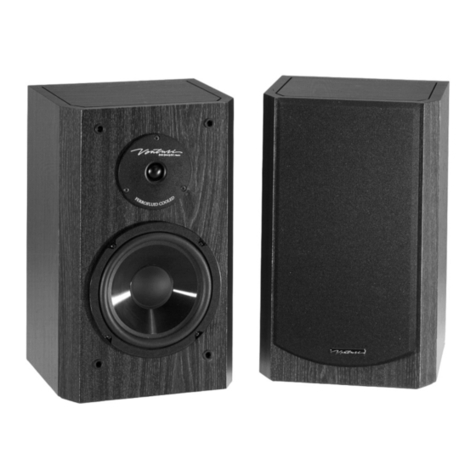
B-I-C America
B-I-C America DV62si User manual
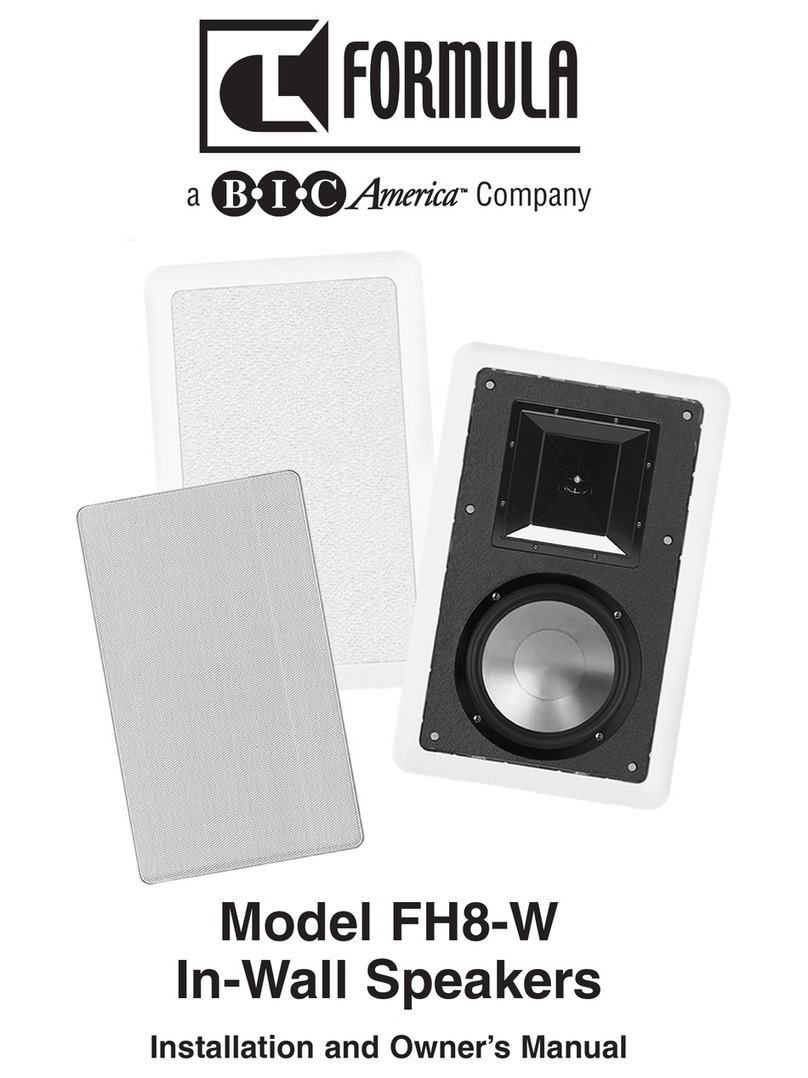
B-I-C America
B-I-C America FH8-W Installation instructions
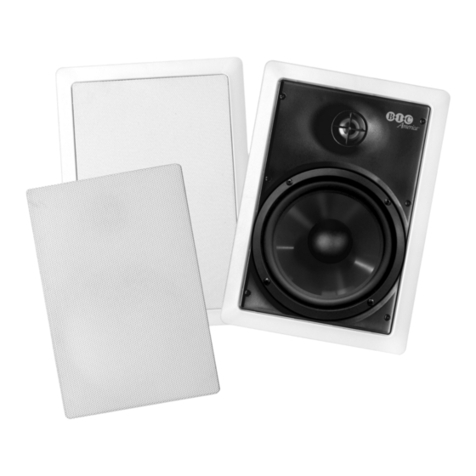
B-I-C America
B-I-C America muro ARCHITECTURAL M-PRO6W Installation instructions
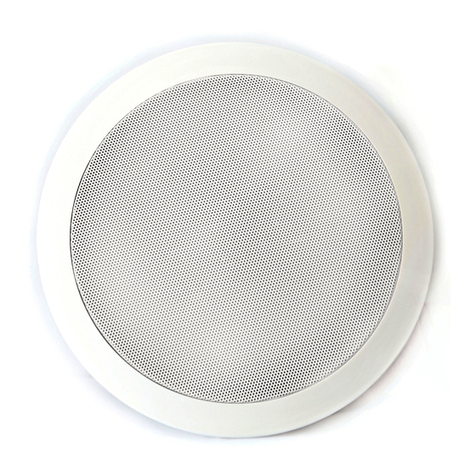
B-I-C America
B-I-C America Muro MSR5D Installation instructions
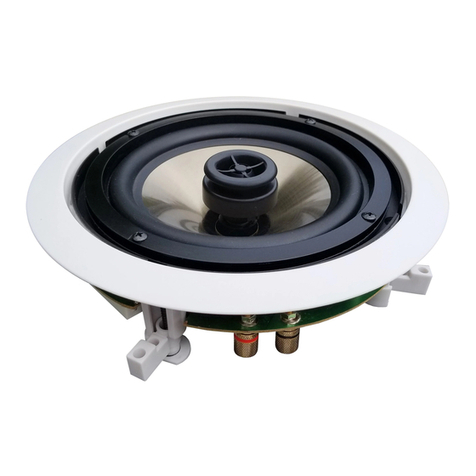
B-I-C America
B-I-C America FORMULA FH6-C Installation instructions
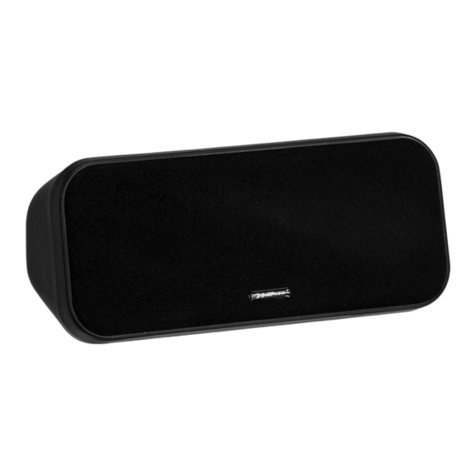
B-I-C America
B-I-C America DV32CLR User manual
